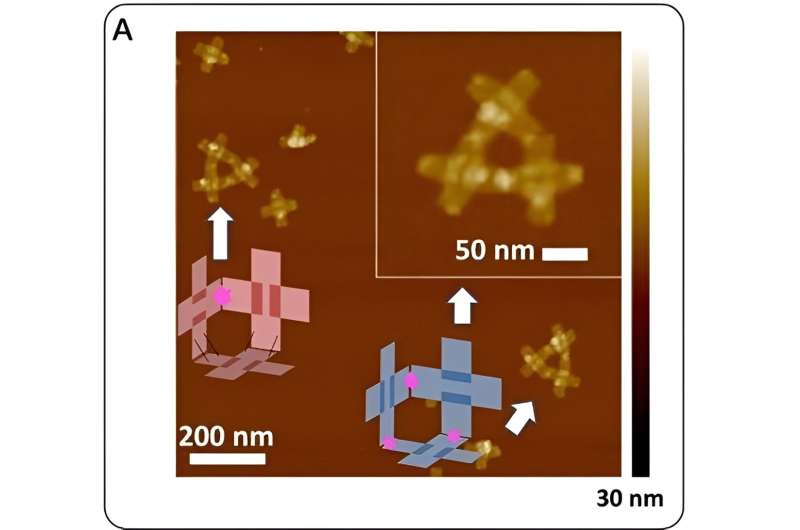December 7, 2023 report
This article has been reviewed according to Science X's editorial process and policies. Editors have highlighted the following attributes while ensuring the content's credibility:
fact-checked
peer-reviewed publication
trusted source
proofread
Researchers create 3D DNA nanorobots

Researchers at universities in New York and Ningbo, China, say they have created tiny robots built from DNA that can reproduce themselves.
Such nanorobots could one day launch search-and-destroy missions against cancer cells within a human's bloodstream without the need for surgery or collect toxic waste from the ocean.
The tiny mechanism is so small that 1,000 of them could fit into the width of a sheet of paper.
"Nanoscale industrial robots have potential as manufacturing platforms and are capable of automatically performing repetitive tasks to handle and produce nanomaterials with consistent precision and accuracy," said Feng Zhou, a lead researcher on the project and staff member at New York University's Department of Physics and the Chinese Academy of Sciences.
Zhou said the 100-nanometer-wide mechanisms manipulate different parts of DNA strands and properly align them so they can be "welded" together and then move on to the next step. They devised a novel means of folding DNA in three dimensions that allows for limitless self-replication.
Prior research into DNA robotics was limited to 2D construction.
"Our introduction of multiple-axis precise folding and positioning as a tool/technology for nanomanufacturing will open the door to more complex and useful nano- and microdevices," Zhou said.
In an interview with NewScientist, Andrew Surman, a chemistry professor specializing in nanomaterials, said, "Assembling these kinds of things is tricky… How things are folded up, both in synthetic things that we make and in biomolecules, is really important. When things are folded wrong, they don't work."
Zhou said that his team's work builds on four decades of advances in DNA nanotechnology. He noted a host of innovative inventions, including machines, enzymes, self-replicators, computers, and nucleic acid "walkers"—applications involving nanomedicine, diagnostic sensing of biological samples, and nanorobotics.
"Our demonstration portends nanomachines and robots programmable and controlled by light and heat for nanoscale production of nanoscale, biocompatible structures and devices," he said.
Richard Handy of the University of Plymouth, England, who did not participate in the study, observed, "It would be a way of adding an enzyme or a protein to a cell without the DNA in the cell needing to make it. You have people that have got genetic deficiencies where they're not able to make an enzyme, so this might be a therapy that would construct the enzyme in the tissue for them. If you've got a load of people with type 2 diabetes and insulin secretion problems, maybe you can get one of these DNA scaffolds to make insulin."
Science fiction has tackled the development of nanotechnological devices, sometimes in apocalyptic tales.
K. Eric Drexler, a pioneer of nanotechnology research, imagined a nightmare scenario in his 1986 book "Engines of Creation."
"Imagine such a replicator floating in a bottle of chemicals, making copies of itself," he said. "The first replicator assembles a copy in one thousand seconds, the two replicators then build two more in the next thousand seconds, the four build another four, and the eight build another eight. At the end of ten hours, there are not thirty-six new replicators, but over 68 billion. In less than a day, they would weigh a ton; in less than two days, they would outweigh the Earth."
He coined the now-famous term "gray goo" that refers to the catastrophic replication of nanobots that ultimately consume all biomass.
Zhou's report, "Toward three-dimensional DNA industrial nanorobots," appears in Science Robotics.
More information: Feng Zhou et al, Toward three-dimensional DNA industrial nanorobots, Science Robotics (2023). DOI: 10.1126/scirobotics.adf1274
Journal information: Science Robotics
© 2023 Science X Network




















